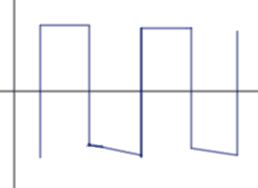Simple Exponential Generator
A simple exponential generator suitable for driving OTA's is built around Q16 and Q17. The emitter of Q17 is riding at one Vbe below ground (Vbe16), so the emitter current is ~11.3v/1M = 11.3uA. The 100K / 1.8K voltage divider formed from R82 and R78 divides the RV1 Frequency adjust voltage to the 18mV/volt level for 1v/octave response. Q17 is an emitter follower, so the voltage changes at the base of Q17 are applied to the base of pnp transistor Q16. Since Q16's emitter is grounded, we are controlling the Vbe of Q16 directly and Ic16 will respond exponentially.This exponential converter should not be used where high tracking accuracy is needed, like in a VCO, because there are a number of error terms. The biggest is probably the base current of Q16 which will subtract from Q17's emitter current at higher current levels. This converter can be used with less demanding circuits like the LFO here, or VCA's or filters.
Triangle - Square oscillator
When an OTA's inputs are overdriven hard, the control current will come in or out of the output, depending on the polarity of the input voltage. U9:A therefore acts as a current switch for the current coming from the exponential converter. U8:A is an integrator. When the the current from the OTA flows into U8:A's virtual ground, U8:A's output will be a linear ramp downward, and visa versa when the current is pulling out of the virtual ground. This is the making of a triangle wave, we just need a way to trigger the directional change of the current source.This is provided by the circuitry around the two transistors Q14 and Q15. It is a "Schmitt Trigger", a comparator with positive feedback. A Schmitt Trigger's output switches states between high and low when the inputs reach certain voltage levels in this case, + and -5v. The output of the Schmitt Trigger is a square wave. It is just the right phase and polarity to drive the inputs of the OTA (through R74 and R75), so that the ramps change direction right at the peaks - a nice triangle wave.
I used the transistor Schmitt Trigger, a circuit from Electronotes, because I thought it might spike the power lines less than the opamp Schmitt Triggers I've used before (for example, U3 in og2's LFO circuit. Pulses from the LFO tend to get into other circuits unless your careful about using separate supply lines, etc. The transistor Schmitt trigger works, but the output square wave is kind of funny:

Opamp Schmitt Trigger
The opamp will be used as a comparator, so choose an uncompensated type like the 748 or uA301. It is hooked up with what looks like an inverter circuit, but the feedback goes to the + input, not the - input, which is grounded. Referring to U3 in og2's LFO, there are two threshhold voltages, governed by these equations:- Eq 1) Upper threshhold VUT = +Vsat*R24/(R24+R7),
- Eq 2) Lower threshhold VLT = -Vsat*R24/(R24+R7),
Calculating frequency, capacitor values
The threshhold points for the transistor Schmitt Trigger occur at +/-5v. A full cycle will then go from -5v to +5v, then back to -5v, for a total traversal of 20v.- Eq. 3) dV/dT = I/C.
- Eq. 4) 1/dT = frequency = I/(dV*C)